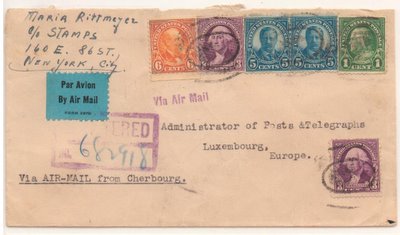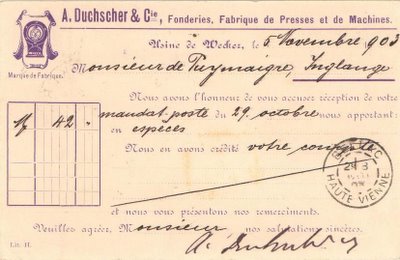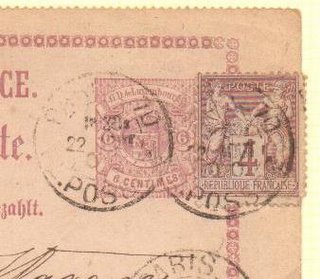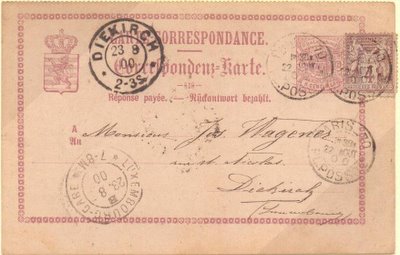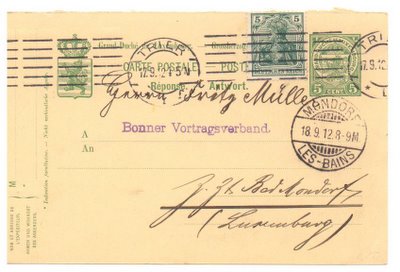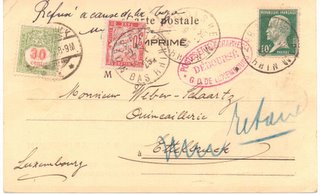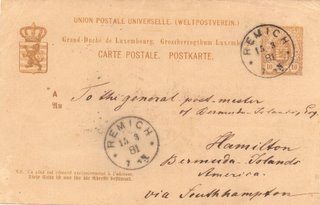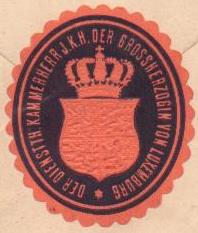 |
Grand Duke William IV’s reign ended upon his death on February 25, 1912. The crown passed to then-princess Marie-Adélaïde, the eldest of his six daughters, who acceded to the throne when she came of age on her eighteenth birthday, June 14, 1912. During the intervening period, her mother, Marie-Anne, continued to serve as regent, as she had since November 13, 1908, when G.D. William IV became incapacitated.
The G.D. William IV official definitives, which had been surcharged officiel in 1908 for government use [Prifix No. 102-113], continued to be used until 1915, when the similarly-surcharged Marie-Adélaïde definitives [Prifix No. 114-128] were issued.
The G.D. William IV definitives, however, remained valid until March 31, 1921. Covers using the G.D. William IV officials during the reign of G.D. Marie-Adélaïde provide a special challenge for the collector of Luxembourg postal history. (A mixed father-daughter franking would be even more scintillating!)
The G.D. William IV official definitives, which had been surcharged officiel in 1908 for government use [Prifix No. 102-113], continued to be used until 1915, when the similarly-surcharged Marie-Adélaïde definitives [Prifix No. 114-128] were issued.
The G.D. William IV definitives, however, remained valid until March 31, 1921. Covers using the G.D. William IV officials during the reign of G.D. Marie-Adélaïde provide a special challenge for the collector of Luxembourg postal history. (A mixed father-daughter franking would be even more scintillating!)
 |
The registered cover shown here, endorsed in violet Service de la Grande Duchesse and franked with the 15-centime and 30-centime G.D. William IV officials, was sent by the Grande Duchesse’s chamberlain. It is sealed with the chamberlain’s official embossed seal (inscribed “DER DIENSTTH. KAMMERHERR J.K.H. DER GROSSHERZOGIN VON LUXEMBURG”).
Posted from Luxembourg-Ville on February 28, 1913, the cover is addressed to Monius Pouret, Commissaire Spécial, in Paris, France. From Paris, it was forwarded to the commissioner who was on a mission in Cap-Martin near Menton in the French Department of Alpes-Maritimes.
The backstamp is that of Cabbé-Roquebrune (today the village of Roquebrune-Cap-Martin).
The 45-centime franking pays 20-centime postage for a letter weighing 20 to 40 grams plus the 25-centime registration fee.
Posted from Luxembourg-Ville on February 28, 1913, the cover is addressed to Monius Pouret, Commissaire Spécial, in Paris, France. From Paris, it was forwarded to the commissioner who was on a mission in Cap-Martin near Menton in the French Department of Alpes-Maritimes.
The backstamp is that of Cabbé-Roquebrune (today the village of Roquebrune-Cap-Martin).
The 45-centime franking pays 20-centime postage for a letter weighing 20 to 40 grams plus the 25-centime registration fee.



